Flies are synonymous with Australian rural and urban landscapes and can be a major pest in commercial premises especially those which practise a less than perfect standard of sanitation. You are no doubt aware that, unfortunately, this is a description of many food manufacturing or handling enterprises in the world. Whether you are in a café, a supermarket, a fish shop or at an outdoor barbecue, you are more than likely to encounter one or more species of fly. These flies are not just a nuisance though, as many of the flies which harass us can be carriers of disease, even some which are potentially fatal.
The major species with which we come in contact are:
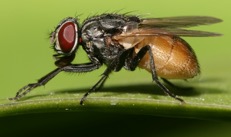
Family Muscidae – House fly
This is a large family with many species which have economic and medical importance. The best known species is the house fly (Musca domestica) which varies in size from 5-8 mm long with a dull grey thorax and abdomen. The adult fly is known to carry many kinds of pathogenic bacteria which can adversely affect man and domestic animals. Adult house flies are commonly found in domestic dwellings and are often seen trying to land on your dinner plate. The larvae can be found in the excrement of animals and also in decomposing organic matter e.g. compost heaps. They are altogether “yucky!” Another well known species is the lesser house fly (Fannia canicularis) which is often distinguished by its erratic flight path rather than its appearance. The adult is 3-6 mm long and thorax and abdomen are dull grey with indistinct stripes on the thorax. Adults can be found in domestic dwellings or animal houses and the larvae feed on organic refuse. A less common species is the stable fly (Stomoxys calcitrans) which is rarely found in houses but can be found in animal production facilities. The fly is about 5-7mm long with distinctive piercing and sucking mouthparts. When at rest, the wings are held widely apart. The larvae feed on a wide range of organic material and the adults feed on the blood of animals.
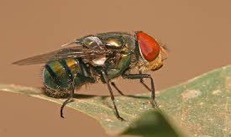
Blow flies or Bluebottles
(Family Calliphoridae)
This too is a large family and members are of a stouter build than Muscidae spp. They are 11- 13 mm long or larger and vary in colour from black, blue, green and bronze. The adults are strongly attracted to moisture and feed mainly on nectar, honeydew and other sweet liquids. Although they can be found in massive numbers at times, blow flies are not significant domestic nuisances or disease vectors. The larvae of some species can cause “blow fly strike” in sheep, a condition which causes millions of dollars of damages annually to the industry.
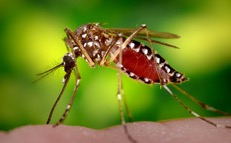
Mosquitoes
(Family Culicidae)
Adult mosquitoes both have a long proboscis which the males use to feed on nectar. The female, however, feeds on blood which leads to the transmission of disease. In Australia, instances of mosquito related disease are mostly isolated to the northern tropical regions but various species can act as carriers for serious diseases such as malaria, dengue fever and filariasis and the Ross River virus in humans as well encephalitis in horses and heartworm in dogs. Mosquito borne malaria is one of the world’s major infectious diseases, killing around two to three million people each year. Australia is host to over 300 species of ‘mossies’ which start their lifecycle as aquatic larvae until the adults emerge as little as one week later, in optimum conditions. The mosquito can exploit a range of fresh and salt water sources – natural or artificial - for breeding habitats. There have been many, many scholarly books written on mosquitoes and the risks they pose. For a wealth of information on Australian mosquitoes and their disease potential, consult the Fact Sheets on the website of the Westmead Hospital Medical Entomology Dept. – www.medent.usyd.edu.au.
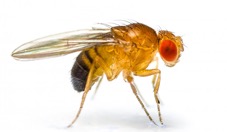
Fruit flies
(family Tephritidae)
Are always found around ripening fruit whereas the Vinegar fly is found primarily around decaying fruit. Fruit flies (Dacus spp.) are important pests to commercial industries and can cause much economic damage if unchecked. The adults feed on sap, nectar, honeydew and droppings. Vinegar (Fermentation, Bar or Beer) flies may become a nuisance in homes, restaurants, fruit markets, etc., especially when associated with decaying or rotting fruit and vegetables. Adult vinegar flies are about 3-5mm long, dull brownish-yellow to brownish-black with red eyes in some species. The head and thorax are tan-coloured, while the abdomen is black and grey underneath. Indoors, these flies may be seen hovering around overripe fruit and vegetables, baked goods containing yeast, garbage cans and beverages/ empty beverage containers, such as fruit juices, cider, soft drinks, beer, wine and vinegar. They can breed alarmingly quickly and may be seen in hundreds alighting on surfaces near food sources. When spotted around the breakfast buffet of a five star hotel, they are less than popular! They can prove extremely difficult to control as many clients are hard to convince that an underlying hygiene issue is the reason why they have a continuing problem with these flies.
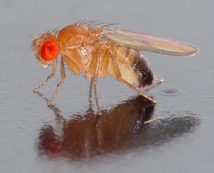
Vinegar Fly
The Vinegar Fly is a small, yellowish fly with distinct red eyes and is commonly seen around rotting fruit.
Feeding and Diet
The Vinegar Fly is not actually a fruit fly as it does not feed on fruit directly, just the yeasts associated with rotting fruit. The name 'fruit fly' is more correctly applied to flies in the family Tephritidae. The larvae feed on the bacteria and yeast found in rotting fruit.
Economic/social impacts
The Vinegar Fly is commonly found in genetics laboratories around the world. This is probably the most studied of all animals (besides humans) and has contributed greatly to our understanding of genetics. Its short life cycle of only a couple of weeks makes it ideal for genetic research.The larvae can cause great problems for wineries and fruit-juice producers.
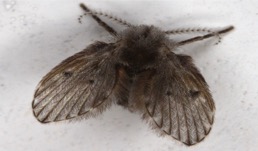
Drain (Moth) flies
(family Psychodidae)
Are most often seen in toilets, bathrooms and sewerage works. Adult flies may become very numerous at times indoors especially around drains, in urinals, on toilet/bathroom walls and around showers and bathtubs. They are invariably a result of drainage problems – blocked or broken drains under the floor or accumulation of organic matter around drain holes. Like the Vinegar fly, they are a consequence of poor hygiene. Adult drain flies are tiny (4-5mm long), fuzzy, dark or greyish insects with the body and wings densely covered with hairs. They have long antennae. Wings, appearing too large for the body, are held roof-like over the body when at rest, giving a moth like appearance. They are weak fliers and make irregular, hesitating flights covering only a metre or so in short, jerky lines.
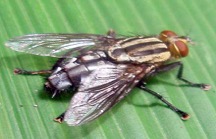
Flesh flies
(family Sarcophagidae)
Are 11-13 mm long with a striped thorax, a patterned abdomen with or without a red/brown tip. They are usually found in the vicinity of carcasses e.g. dead rats or possums. If you see these flies sitting on a ceiling or wall, you can be almost certain that there is a dead animal behind the surface. If you can detect a horrendous smell, your suspicions are confirmed!
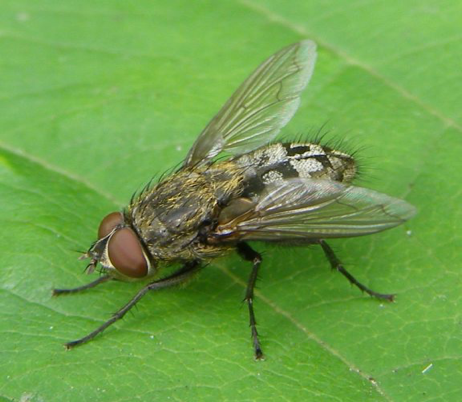
Cluster flies
(Pollenia rudis)
Cluster flies, also known as attic flies, are household pests. Adults measure 6 to 10 millimetres in length and have light and dark grey-checker abdomens. Cluster flies are slightly larger and darker than the common housefly and move more sluggishly.
Lifecycle
Eggs laid in soil in late summer or early autumn.
Larva develops in earthworms – feeding on their host for several days. Then they moult and pupate in the soil.
Development time from egg to adult is about 27 to 39 days.

Sciarid
(family Sciaridae)
Are an extremely widespread family of small flies. The larvae of some species are commonly found in large numbers in rotting vegetable matter or highly organic soils. Pest managers may encounter them in situations where the occupants of the premises have pot plants or gardens in which the larvae are breeding. The adult flies may annoy the occupants and make them believe that they are being bitten by the flies. Such situations can be difficult to treat.
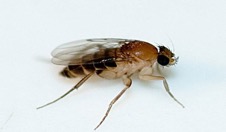
Phorid (Hunchback) flies
(family Phoridae)
Are similar in habit to Sciarid flies but their larval habits vary greatly, some living in decomposing organic matter and some scavenging in carrion. The adults are small to minute in size with a relatively large thorax, hence the common name of “Hunchback” flies. They too can be found in premises where pot plants or gardens are found and can give rise to the illusion that they are biting the occupants.
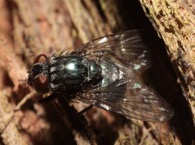
Bush flies
(Musca vetustissima)
Why they pester you
The female bush flies pester you most. They want protein. They need it to develop their ovaries, to prepare eggs for the next generation of bush flies.
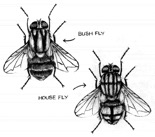
They get protein from your tears, saliva, and the mucus in your nose -- and from blood, if you have any fresh cuts. To be blunt, they are also hoping you might do a poo. Bush flies are programmed to stay around animals, because animal dung is their favourite place to lay eggs. Sometimes they drink sweat. It hasn't got much protein in it -- not nearly enough. But it's useful if the flies are thirsty, and it has some minerals they can use. Male bush flies probably hang around you mostly to be near the females! They don't need much protein. When bush flies swarm around you, there are usually about three females for every male.
Biting flies
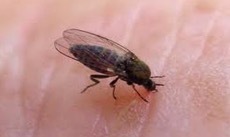
Sand Fly
(Spiriverpa Lunulata)
Sand flies Adult: 10–11mm long.
Adult sand flies can be seen from April to September. They live on sandy riverbanks with an open habitat free of shading trees. Sand fly activity is heaviest at sunrise and sunset (normal feeding times for most things) and reputedly virulent nearing and on the full moon, although there is no evidence to prove this. You are probably better off concentrating on other mythological phenomena like werewolves and vampires around the full moon and just developing an overall strategy for sand flies.
The female sand fly bites humans in order to get protein from the blood - necessary for egg laying and reproductive cycles. The bite involves the injection of saliva containing an anti-coagulant, making it easier for it to draw blood from its host. The saliva contains allergens that trigger the body’s immune system and red welts and lesions develop. In Australia sand flies are unlikely to transmit disease although they are problematic in more northern countries like the Philippines.
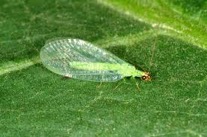
Green Lacewing
Chrysoperia carnea
The green lacewing is another one of the most effective predatory insect known. It’s a GOOD BUG.
THE "APHID LION" After a few days, the eggs hatch and tiny larvae emerge which are also known as “aphid lions" because of their voracious appetite. There is no other better predator known to consume vast quantities of eggs and the soft bodies of aphids, mealy-bugs, spider mites, leafhopper nymphs, caterpillar eggs, scales, thrips, and white-flies. The lacewing larvae attack the eggs of most pests and, if the bodies are not too hard and fast moving, will attack the adult pest stage as well.

Horse flies
(Family tabanidae)
Horse flies are a particular pest to livestock. Relentless biting attacks by females can result in reduced weight gain in some animals.
Horse flies varying in length from about ½ to 1 ¼ inches long, are black or gray in colour and often have large, brilliant green eyes. The blood feeding female horse fly is equipped with blade-like mouthparts, which slash tissues and blood vessels and cause blood to flow to wounds. Females then use their sponge-like mouthparts for sucking up blood. Males only feed on pollen and nectar.
THREE CONTROL PARAMETER
EXCLUSION
Obviously, if you can prevent flying insects from entering a building, your worries are almost over. Some exclusion measures are:
Flyscreens – these are placed on doors and windows and are effective if maintained properly. Poorly fitted screens, holes in screens or doors/windows left open negate their value.
Airlocks – if these are properly designed, located and maintained, they are an effective method of preventing the entry of flying insects, especially if used in conjunction with aerosol dispensers or electronic control units.
Air curtains
These systems are not in widespread use due to cost and varying degrees of efficiency. One could write a whole bulletin just on their use. If the systems are not adequate in power or not sited correctly, they do not provide the degree of protection that might be expected. Flies may simply drop to the ground and walk inside the premises or be carried in on the backs of forklift drivers. Consult with a reputable supplier before recommending such a device.

Strip curtains
These units are usually made of plastic of varying design and thickness. Smaller designs are used in domestic premises. There is often a gap at floor level allowing insect entry and when used in loading docks etc. flies can still enter on the backs of staff members or on goods. Sometimes, their value is completely negated when the strips are used as “garlands,” tied back to door handles, fire extinguishers etc.
RESTRICTION
“Restriction” means basically reducing the breeding potential of the pests by eliminating food sources or potential breeding sites. Some of the elements of an effective “Restriction” programme are:
Waste disposal – obviously where you have waste disposal, you have, by definition, food wastes, liquids and other items such as packaging material. What else could any pest ask for? On large sites, dumpsters and bins should be located on a raised platform which is, in turn, on a sloping concrete pavement, allowing for effective drainage and washing down. Containers should be closed when not in use but, all too often, you see dumpsters or skips uncovered and attracting flies, cockroaches, ants, rodents and birds. All waste bins etc. should be situated a distance from the building itself and not in an area where the prevailing winds will carry odours into interior areas. They should be emptied on a strict schedule and not be allowed to overflow. Let me know if you ever see a site where all these rules are obeyed! •
Breeding site removal – this applies especially to mosquito control where it is an important factor in a control programme. This could involve disposing of old tins, tyres, buckets and similar containers, ensuring that there is no free standing water and changing water in such things as bird baths and wading pools. It is also very important in the control of vinegar flies where the larvae may be feeding in the locations previously mentioned as well as less obvious places as used tablecloths, table napkins, aprons, bar mats, rubber floor mats, soft drink dispensers, rarely cleaned drains and walls. Without the proper and regular cleaning of such items, control is virtually impossible. •
External lighting
Mercury vapour lamps, fluorescent tubes and incandescent bulbs are all more attractive to flying insects than high pressure sodium vapour lamps. Specially coloured “insect” bulbs can be used to reduce the attraction factor and external lights should be placed 5-6m away from doorways. Ideally, high pressure sodium vapour lamps should be used exclusively in external areas. Lights should be placed on poles some distance away from the building rather than being attached to the building itself.
DESTRUCTION
Now, this is where we come in. There are a wide range of chemical and non-chemical control measures with new insecticide formulations being introduced fairly regularly. Some of the insecticidal formulations we might use include:
Fly bait
There are a few options available. They are usually a granular formulation and one very effective product can be applied as a dry granule scattered around, placed in purpose built bait stations or just in trays, or mixed into a paste and applied to vertical surfaces such as timber poles or to pieces of timber mounted on platforms or suspended in the air. You can kill up to a thousand flies per hour with such a formulation!
Residual insecticidal application
The use of Synthetic Pyrethroids to fly alighting surfaces e.g. around entry doors, windows and waste bins, will repel and also kill flies. The addition of sugar will help attract house flies to the treated surface. Some insecticides are mixed with water and painted on to an appropriate surface. As well as the active ingredient these products also contain sugar and a sex attractant. If food doesn’t turn them on, then the prospect of a night out with a good looking female fly will certainly do the trick!
Drain cleaners
These are not your everyday cleaners but specially formulated products used to clean drains and pipes of organic matter, thus removing potential food sources for vinegar flies. They are available in a number of formulations including a foaming variety which is most effective.
Metered aerosol dispensers
These are a salesperson’s best friend! They have been sold for the control of nearly every pest (except rats) for spaces as large as the Sydney Cricket Ground! Needless to say, they are only effective against flying insects in limited spaces e.g. store room, cleaner’s room and garbage room
Many units have the ability to be set to operate within certain hours e.g. after close of trading until just before opening. For insect control these dispensers use a pyrethrin based insecticidal spray and they can also be used with aerosol cans which dispense an aromatic fragrance. If you have one of each spraying, the flies die happy!
(The pyrethrins are a class of organic compounds normally derived from the chrysanthemum flowers, thus is often considered an organic insecticide0
Monitoring
Glue board electric fly catcher
Electronic fly killers do not act like vacuum cleaners, sucking all flies in the vicinity into its jaws. There are many factors to consider such as the knowledge that flies will not respond to UV tubes at distances greater Than 30-40 metres and do not actively respond until some 10 metres away but can show a distinct positive response when the distance is 4 metres or less.
Flies vary in their degrees of responsiveness to fly killers during a given period. They will go through phases of attraction to complete disinterest but, tests show that around 90% of flies contained in a given volume will be caught within 24 hours.
The height of units is critical to effective operation. It is installed 2 meters of the ground
Units should be located near all potential entry points and, if possible, at right angles to the nearest window or light source. They should not be visible from outside the premises otherwise they may attract more flies inside than were there previously!
Suspended units should be preferably at least 2 metres from light coloured walls as UV light reflected from these surfaces tends to reduce effectiveness.
It is essential that all UV tubes are changed according to their makers’ specifications. Their efficacy drops off sharply after their scheduled life which may be 6 or 12 months.
Benefits to your business:
- Insects are caught quickly onto glue boards
- Reduces risk of contamination from flying insects
- Eliminates risks of secondary infestation
- Uses very little current
- Effective against all types of flying insects
- Safe to use in the most sensitive areas
- Fulfils legal and health & safety requirement

The electric fly catcher is used as part of Redknight Exclusion, Restriction, Destruction and Monitoring approach to ensure you have effective, long-term protection from flies for your business.
Experts in fly removal in Melbourne, Ballarat and Geelong - Redknight Termite & Pest Control
